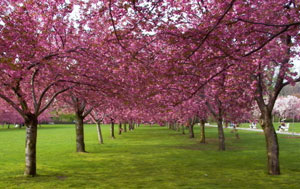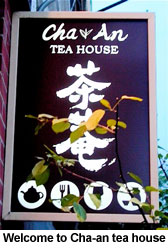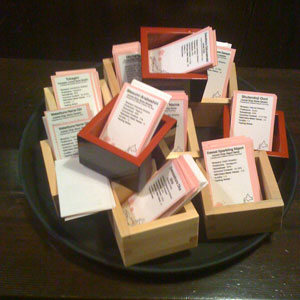Cha-an Namazake Hanami
 Ok, one thing I’ve certainly learned in my pursuit to understand even a little bit about Japanese culture over the years is that the Japanese sure do love their cherry blossoms. There is even a specific word for the activity of “flower viewing” called Hanami which basically consists of picnicking under the cherry tree and admiring the beauty of the flowers and hoping a flower petal will float down and land in your sake cup.
Ok, one thing I’ve certainly learned in my pursuit to understand even a little bit about Japanese culture over the years is that the Japanese sure do love their cherry blossoms. There is even a specific word for the activity of “flower viewing” called Hanami which basically consists of picnicking under the cherry tree and admiring the beauty of the flowers and hoping a flower petal will float down and land in your sake cup.
 Well our friend Chizuko-san, sake sommelier at Sakagura, hosted her own version of springtime Hanami at Cha-an tea house with a special emphasis on that delicious and ever more popular unpasteurized nama sake. I didn’t get a sakura petal to land in my cup, but I had some fantastic nama. The Chef at Ch-an, Tomoko Kato-san, provided course after course of really scrumptious appetizers.
Well our friend Chizuko-san, sake sommelier at Sakagura, hosted her own version of springtime Hanami at Cha-an tea house with a special emphasis on that delicious and ever more popular unpasteurized nama sake. I didn’t get a sakura petal to land in my cup, but I had some fantastic nama. The Chef at Ch-an, Tomoko Kato-san, provided course after course of really scrumptious appetizers.
Of the sakes served, here were some of the highlights that stood out for me:
Masumi Arabashiri Junmai Ginjo Nama Genshu: This is rich and full and the fresh, fresh flavor is alive with a fruitiness that may come across a touch sweeter than it actually is. This sake tastes alive and makes me happy to be alive.
 Eiko Fuji Junmai Ginjo Nama Genshu: light and very elegant sake. I found this sake super refreshing and radiating luscious hints of all those summer fruits you love. more expensive and worth it.
Eiko Fuji Junmai Ginjo Nama Genshu: light and very elegant sake. I found this sake super refreshing and radiating luscious hints of all those summer fruits you love. more expensive and worth it.
Shutendouji Oh-Oni Junmai Ginjo Nama Genshu: One cool thing about this sake is that the brewery uses home grown sake rice, which is not usually the case. The flavor of this sake is full-on genshu – you really feel the full weight of the almost 18% alcohol, but it is balanced with wonderful nama fruit and thankfully not too sweet.
Kamikokoro Toukagen Shiboritate Tokubetsu Junmai Nama Genshu: This sake is one of my favorites and winner of the 2007 Golden Masu Award for best nama. hazaah! Of course, one of my favorites! This Ohkayama sake always heralds the coming of spring and to me is “spring in a bottle”. On the sweet side and fruity, this is a very, very, very easy to drink sake. They use a peach yeast to give it an extra punch of strawberry-licious flavor. yum-o.
Other sakes of note that we tried were Dewazakura Oka Ginjo, Dassai Sparkling Nigori Nama and Wataribune Nama Ginjo. This tasting was stand up cocktail party style and very popular! It didn’t take long for ‘sake magic’ to kick in and everyone was chatting up a storm and comparing sake flavors and pronouncing their favorites. I think a few new sake fans were brought into the flock on this night. Thanks, Chizuko-san for spreading the word on Nama!


